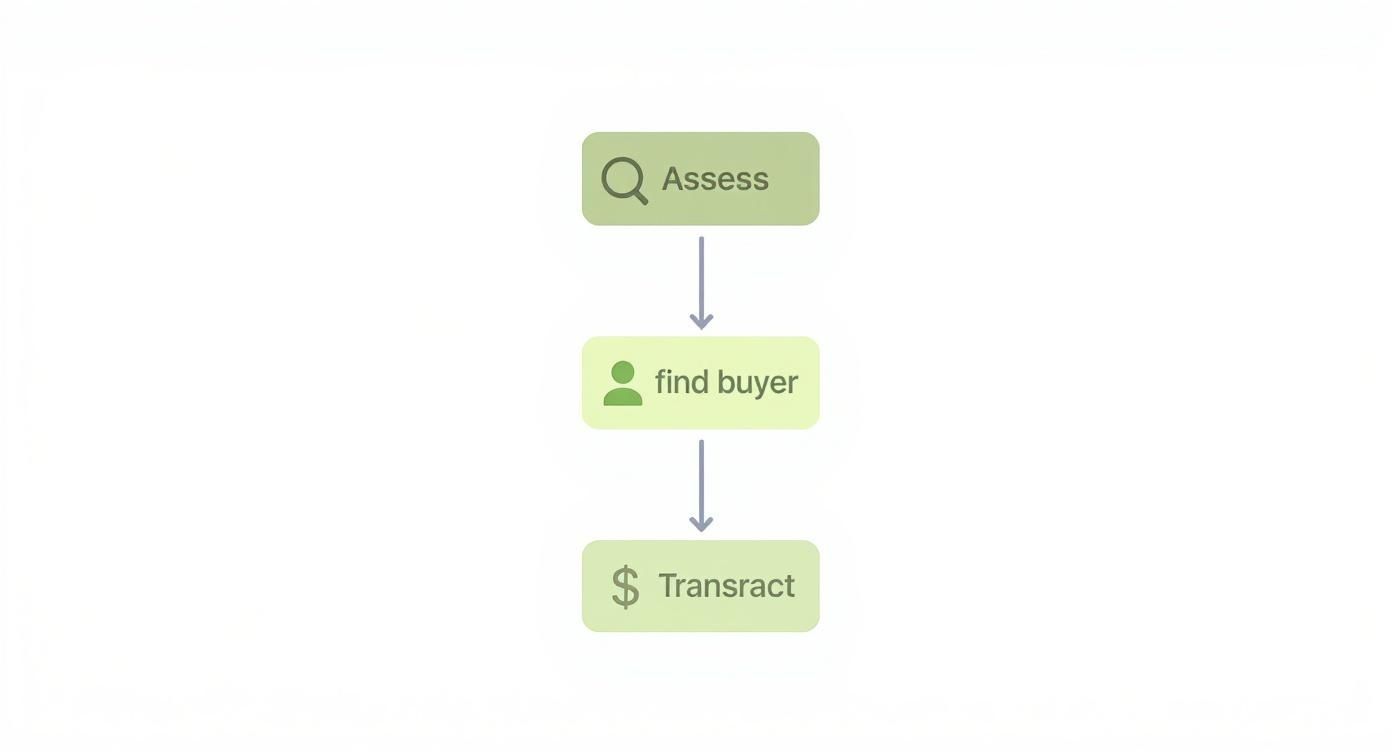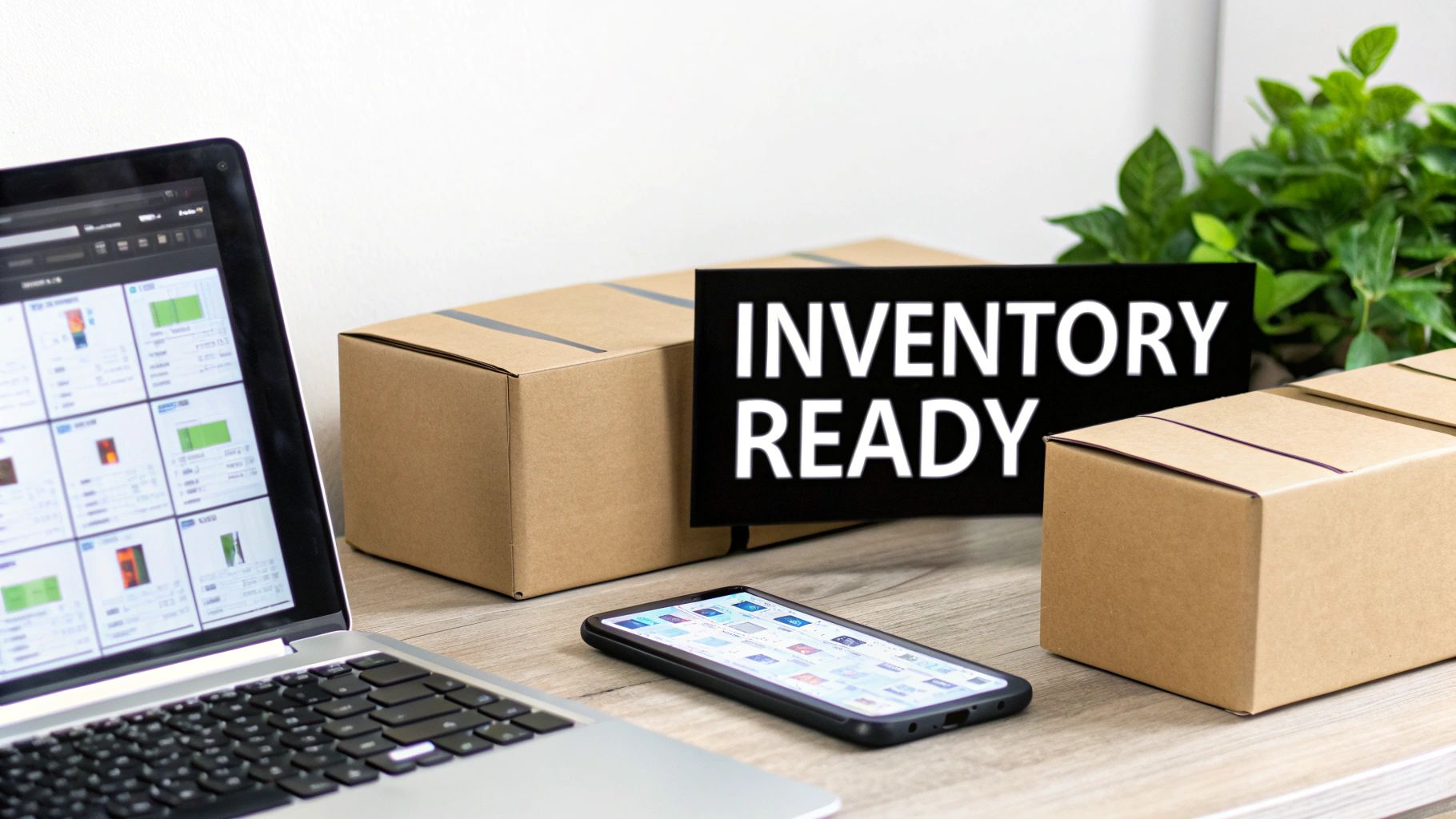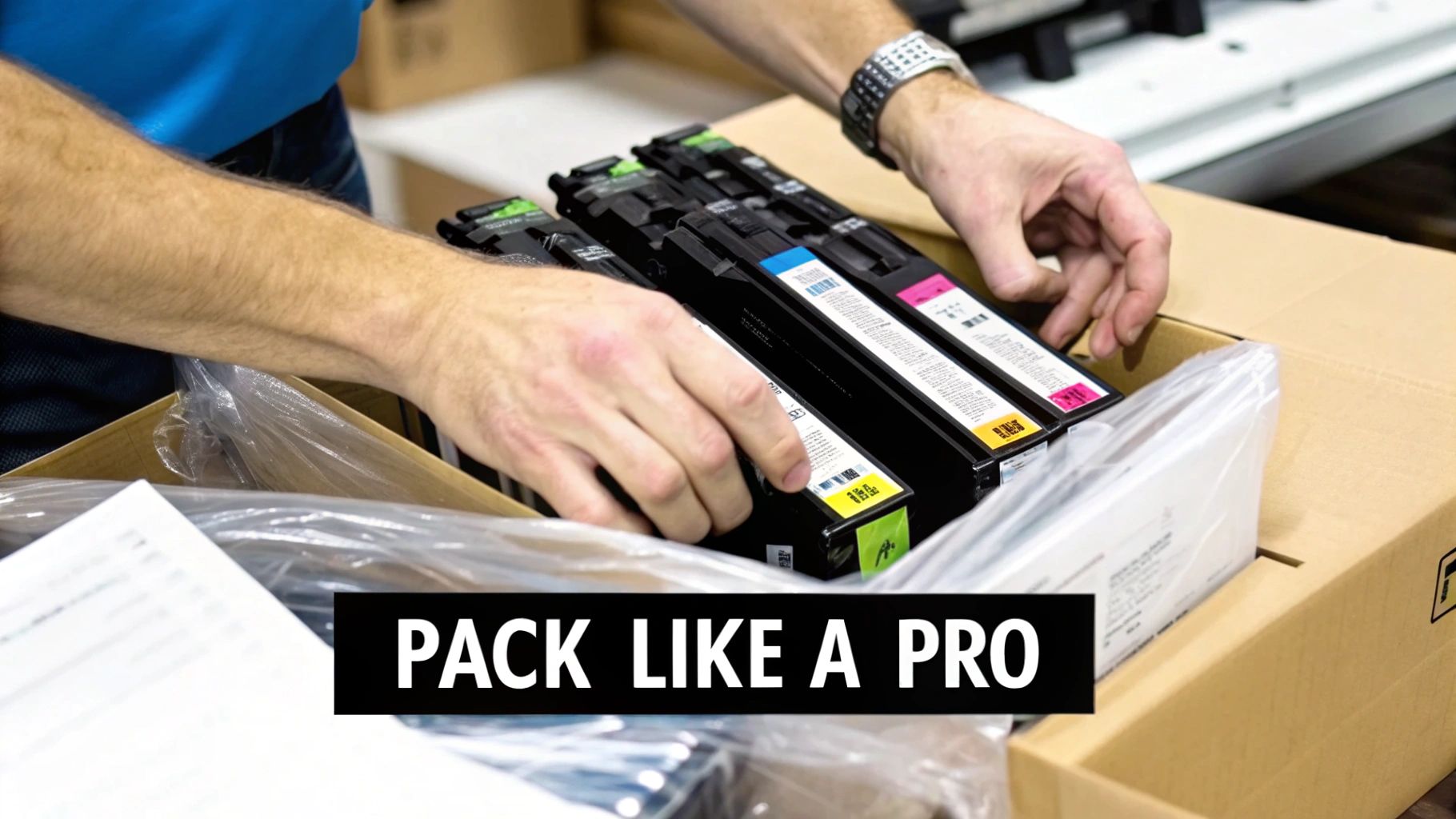That closet full of old toner cartridges? It’s not just clutter—it’s cash waiting to be collected. When you want to sell unused toner cartridges, it really comes down to three things: knowing what you have, finding a buyer you can trust, and making sure the whole process is smooth and secure.
This guide will walk you through exactly how to turn that forgotten office supply surplus into a real asset for your business.
We've all seen it. That one supply closet that becomes a graveyard for outdated tech and over-ordered items. Tucked away on a back shelf, you’ll almost certainly find a few sealed boxes of toner for a printer the company got rid of last year. These aren't just taking up valuable space; they’re a tangible asset you can liquidate.
It happens all the time, and usually for a few common reasons:
Selling your surplus is just a smart financial move. Instead of letting hundreds—or even thousands—of dollars in assets gather dust, you can put that money right back into your budget. For instance, a single high-demand OEM cartridge, like an HP 58X, can easily fetch over $100. If you've got ten of them sitting around, that’s a quick and significant return.
The global toner cartridge market is a massive industry, projected to hit around $18-20 billion by 2025. This proves there’s a consistent, strong demand for these products, which is what fuels a healthy and reliable secondary market for unused supplies.
Beyond the cash, it’s also a genuinely good environmental choice. Rather than letting perfectly good products end up in a landfill, you’re putting them back into circulation. It's a simple way of contributing to a circular economy by keeping manufactured goods in use for as long as possible.
Think of this as your quick-start guide to getting this done. For office managers trying to make sense of the process, here's a simple breakdown.
| Phase | Key Action | Practical Example |
|---|---|---|
| 1. Inventory & Prep | Gather all cartridges and take clear photos of the boxes. | Lay out your 10 HP and 5 Brother cartridges on a clean table. Take a group photo, then individual shots of any box damage. |
| 2. Get a Quote | Submit your list to a reputable buyback company for a valuation. | Email your spreadsheet to two different companies with the subject "Quote for 15 Unused OEM Toner Cartridges." |
| 3. Ship & Get Paid | Pack the cartridges securely and ship them using the provided label. | Place the cartridges upright in a sturdy box, fill gaps with crumpled paper, tape it shut, and attach the prepaid UPS label. |
This table gives you the immediate, actionable steps to get started. By turning those forgotten boxes into a new revenue source, you’re making a decision that’s good for your bottom line and the planet.
If you're ready to see what your inventory is worth, the easiest way to begin is to submit your list and get a fast, no-obligation quote.
https://tonerconnect.net/sell-unused-toners/submit-form
Before you start looking for buyers, it’s crucial to understand what makes one box of toner valuable and another nearly worthless. In the eyes of a buyback company, not all cartridges are created equal. The single biggest factor? Whether your cartridges are OEM (Original Equipment Manufacturer) or a third-party alternative.
Genuine OEM cartridges—the ones made by the big names like HP, Canon, or Brother—will always bring in the most cash. Buyers pay a premium for them because they know they’re getting guaranteed quality, reliability, and perfect compatibility. On the flip side, most reputable buyers won’t even consider compatible, generic, or remanufactured cartridges due to their inconsistent performance and quality. For example, a genuine HP 414X toner cartridge will receive a strong offer, while a "compatible with HP 414X" cartridge from an unknown brand will likely be rejected.
This quick infographic breaks down the simple decision-making process, from that first look in your supply closet to getting paid.

As you can see, that initial assessment is where you really set the stage for a good payout. It all starts with what you have and what condition it's in.
After you've confirmed you have genuine OEM cartridges, the next thing a buyer looks at is the box itself. It might seem minor, but the physical condition of the packaging is a huge deal. Buyers grade boxes on a simple scale, and even small cosmetic flaws can knock down your offer. A perfect box looks like it just came off a retail shelf, which signals that the product inside is just as pristine.
The grading system is pretty straightforward. Here's a look at how a few dings and scuffs can directly affect your final payment.
| Grade | Box Condition Description | Practical Example |
|---|---|---|
| Grade A | Pristine Condition. Looks brand new, straight from the factory. No dents, tears, writing, or broken seals. The gold standard. | A box you just received from a supplier, with sharp corners and a flawless finish. |
| Grade B | Minor Imperfections. Shows light wear. Think slight scuffs, a small crease, or a carefully removed shipping label. | A box that has a small, quarter-sized dent on one corner from being moved around in the supply closet. |
| Grade C | Noticeable Damage. Has obvious flaws like significant tears, large dents, water stains, or writing on the packaging. | A box with "Marketing Dept" written in permanent marker on the front, or a noticeable coffee stain. |
Basically, the better the box looks, the more money you’ll get. It's as simple as that.
Pro Tip: One of the most common mistakes I see is leaving old shipping labels on the box. This can instantly downgrade your cartridge from Grade A to B or C. Always try to remove them carefully. For example, using a hairdryer on low heat can sometimes soften the adhesive, allowing you to peel a label off cleanly. Even if it causes a small, neat tear, that’s usually better than a big, ugly label plastered across the front.
The last couple of factors that can influence value are the expiration date and whether it’s ink or toner. For inkjet cartridges, that date printed on the box is a deal-breaker. Most buyers won't take ink that's already expired or has less than a year left before it does. While toner powder doesn't technically "go bad" in the same way, newer stock is always preferred and will fetch a higher price.
It’s also interesting to see the bigger picture here. While buyback companies are focused on OEM products, the demand for reused cartridges is on the rise. In fact, the remanufactured cartridge market is projected to hit USD 1.7 billion by 2025. This growth is being pushed by businesses and people looking to save a little money and be more eco-conscious. It just goes to show there’s real value in those supplies—you just need to find the right home for them. You can discover more insights about the remanufactured cartridge market growth and see how the industry is shifting.

If you want to get the best price for your surplus toner, the work starts before you even think about contacting a buyer. How you organize and present your inventory can make a huge difference in the offers you get back. A clean, professional list tells buyers you’re serious and makes their job easier—and that almost always means more money in your pocket.
Put yourself in their shoes for a second. An email that just says, "I have some extra HP toner to sell," is a dead end. They can't quote that. But an email with a clear list of 15 HP 58A cartridges, complete with notes on box condition, will get a fast, competitive offer every time.
First things first, you need to create a master list of exactly what you have. This isn't just about a quick head count; it's about capturing the specific details every buyer needs to give you an accurate valuation. This organized approach is absolutely crucial when you want to sell unused toner cartridges, especially if you have a decent amount.
To put together a list that gets results, make sure you have this info for every single item:
The easiest way to do this is with a simple spreadsheet. List everything out with those columns. For example, a single line item might look like this: HP, CF258X, 8, A Grade (perfect boxes), N/A. That single document becomes your tool for getting competing quotes from multiple buyers, which saves you a ton of time and hassle.
A detailed list is great, but pictures are what really seal the deal. When a buyer can see your cartridges for themselves, it builds immediate trust. They can visually confirm the box condition, check for authenticity, and know exactly what they’re bidding on. Good photos cut through the back-and-forth emails and get you paid faster.
Seriously, taking five extra minutes to snap a few clear photos of your inventory is one of the best things you can do. A buyer who sees pristine boxes with intact security seals is going to give you their best offer right away, no questions asked.
For example, a close-up of an undamaged HP holographic security seal is solid proof that you have the real deal. On the flip side, if a box has a crushed corner or a shipping label on it, take a picture of that, too. Being transparent about any flaws avoids headaches and disputes down the road. For some great examples, check out these instructions on how to submit images that maximize your offer. A little prep work here makes you look like a pro and keeps the whole process running smoothly.

Okay, you've got your inventory list organized and ready to go. Now comes the crucial part: finding a buyer who will give you a fair price. The trick is knowing where to look and how to spot a professional operation versus a fly-by-night outfit. Your goal here is to sell unused toner cartridges efficiently and get the best possible return on that dormant asset.
You generally have three paths you can take to offload your surplus supplies, and each has its own pros and cons.
If you're curious about the online marketplace route, understanding the ins and outs of selling used items on platforms like Amazon can give you a good idea of the work involved in secondary markets.
Vetting potential buyers is hands-down the most important thing you'll do in this process. A little due diligence upfront can save you a world of hurt later—think surprise fees, ghosting after they get your shipment, or painfully slow payments. A reputable buyer will be transparent and professional right from the start.
Here are a few green flags I always tell people to look for:
The demand for these products is absolutely massive. Globally, over 1.5 billion ink and toner cartridges are sold every year, feeding a market worth around USD 25 billion. This huge secondary market attracts some fantastic, honest buyers… and some you’ll want to steer clear of.
This might sound obvious, but you’d be surprised how many people don’t do it: never accept the first offer you get. Treat this like any other business deal. The only way to know you're getting a fair market price is to get multiple quotes. My advice is to send your detailed inventory list to at least three different reputable buyback companies.
Don’t just get fixated on the final dollar amount. A slightly higher offer might come with strings attached, like a complicated shipping process or ridiculously slow payment terms. For example, Buyer A might offer $550 with free shipping and payment in 3 days, while Buyer B offers $575 but requires you to pay for shipping and has a 30-day payment cycle. Buyer A is the better overall deal. The best deal is the right mix of a great price, free and simple shipping, and a fast, reliable payout.
By being a little strategic, you can confidently pick a partner who offers the best overall value. This turns what was once just clutter in a supply closet into cash for your business with minimal fuss.

You’ve done the legwork of cataloging your cartridges and have a great offer in hand. Now comes the final, crucial step: getting everything to the buyer in one piece. Proper packing isn't just a friendly suggestion—it’s the one thing that guarantees you get paid the full amount you were quoted.
A damaged shipment can quickly turn a profitable deal into a total loss. When a pristine, "A Grade" cartridge shows up with a crushed corner because it was banging around in the box, its value plummets. The buyer will either downgrade it or reject it outright. This is the last mile of the process, and you have to nail it.
Your first move is to find the right shipping box. It needs to be strong enough for the journey and, just as critical, the right size. A box that's way too big lets your items shift and tumble, while one that’s too small leaves zero room for protective padding.
Look for a box that leaves about two inches of space for cushioning on all sides of your cartridges. For instance, if you have a dozen toner boxes that form a 14×10 inch block when grouped together, you’ll want a shipping box that’s around 18×14 inches. That gives you plenty of room to stuff in bubble wrap or packing paper.
The Shake Test: The goal is to create a snug, immovable brick of items inside the box. If you can seal the box, give it a good shake, and hear or feel things shifting around, you need to go back and add more padding. A real-world example is packing wine bottles—you want them so secure that nothing clinks or moves.
How you arrange the cartridges inside the box makes all the difference. Never, ever just toss them in there. The best practice is to pack them upright, standing vertically like books on a shelf. This orientation uses the box’s own structural integrity to its advantage and dramatically reduces the risk of damage.
Once your cartridges are in place, your mission is to fill every last bit of empty space.
Taking these few extra minutes ensures your items arrive in the exact condition you sent them. That means a smooth final inspection and a fast, full payment.
Here’s the best part: you almost never have to sweat the shipping details yourself. Any reputable buyback company will make this incredibly simple by providing prepaid and insured shipping labels. This means zero out-of-pocket shipping costs for you.
You’ll typically get a PDF label emailed to you from a major carrier like UPS or FedEx. Just print it out, stick it on the box, and drop it off. Better yet, you can usually schedule a pickup right from your office, saving you a trip. You can learn more about how professional shippers handle these logistics to see just how streamlined the process can be.
Even after laying out the steps, a few questions always pop up. It's completely normal. Things like payment, shipping, and what to do with a less-than-perfect box can feel a bit fuzzy the first time you sell your extra toner. Let's clear up the most common sticking points so you can move forward confidently.
Getting these final details sorted out is what makes the difference between a smooth transaction and a frustrating one.
This is probably the single most important question we get. The condition of the original box directly impacts the cartridge's value. While some buyers might take a box with a few dings or scuffs (often called 'B' or 'C' grade), expect a significant price drop compared to a perfect, factory-sealed box.
Here’s the hard truth: An open box is almost always a deal-breaker. Even if the foil bag inside is still sealed, reputable buyers won't touch it. That factory seal on the outer box is their only guarantee that the product is genuine and untampered with.
To avoid any headaches, be completely transparent. Snap clear, well-lit photos of any tears, dents, or broken seals and send them with your list. This allows the buyer to give you an accurate quote right from the start, so there are no bad surprises later.
Legitimate buyback companies make getting paid simple. You’ll typically have a few choices to fit your company's accounting preference:
Payment is always sent after your shipment arrives and is inspected. Once the team verifies the items match your list—usually within 2-5 business days—your payment is processed immediately. For example, if your shipment arrives on a Monday, you can typically expect your payment to be sent by Wednesday or Thursday of the same week.
You shouldn't pay a dime for shipping. Period.
Any established, professional toner buyer will provide you with prepaid shipping labels from major carriers like UPS or FedEx. This is non-negotiable and a hallmark of a trustworthy company. Not only is the shipping free for you, but it’s also fully insured.
If a buyer ever asks you to pay for shipping upfront, consider it a massive red flag. Standard industry practice is for the buyer to cover all logistics costs, making the entire process completely free and risk-free for you.
Ready to turn your surplus toner into cash without the hassle? Toner Connect LLC offers top-dollar quotes, free prepaid shipping, and fast, reliable payments. Get your no-obligation offer today and see what your unused cartridges are worth at https://tonerconnect.net.
Article created using Outrank